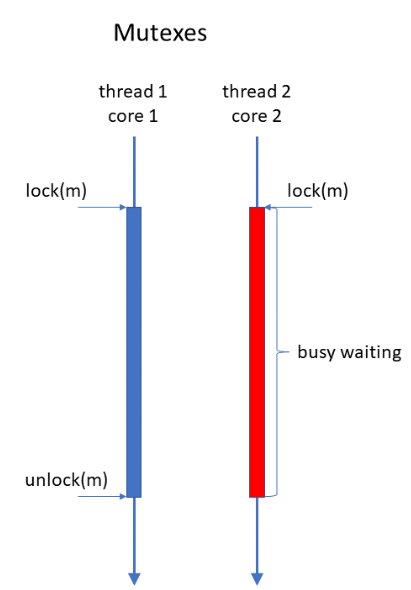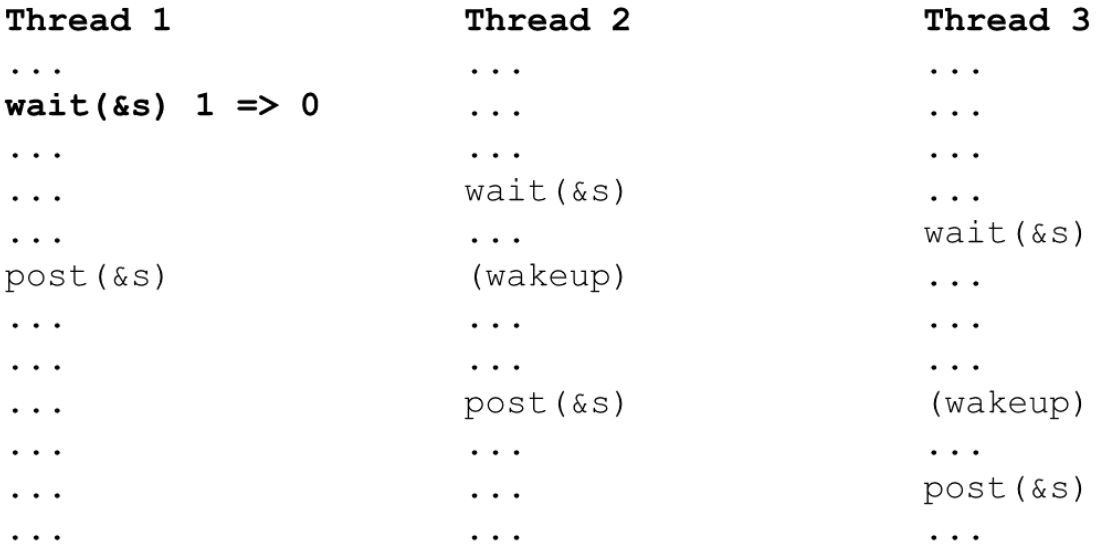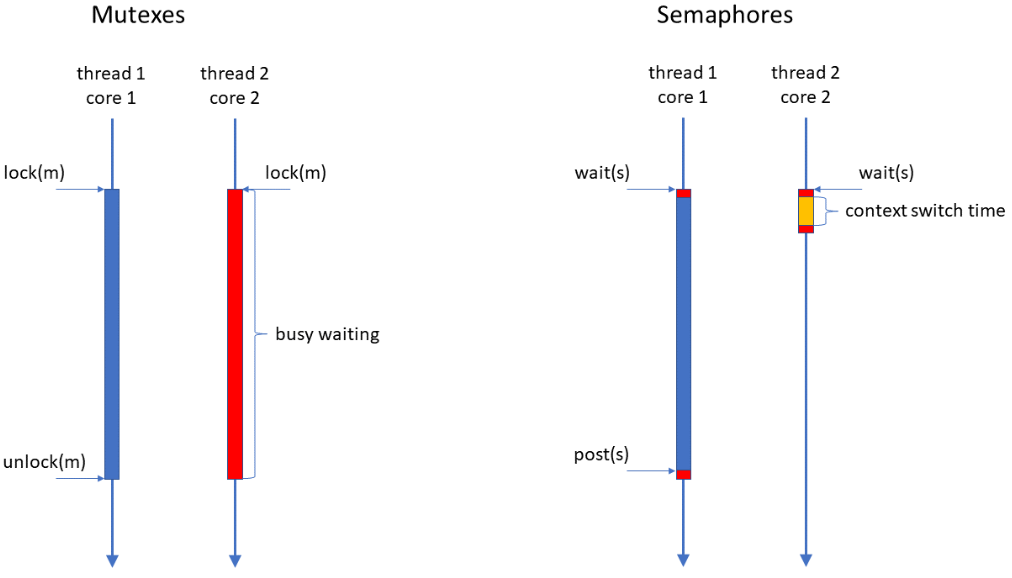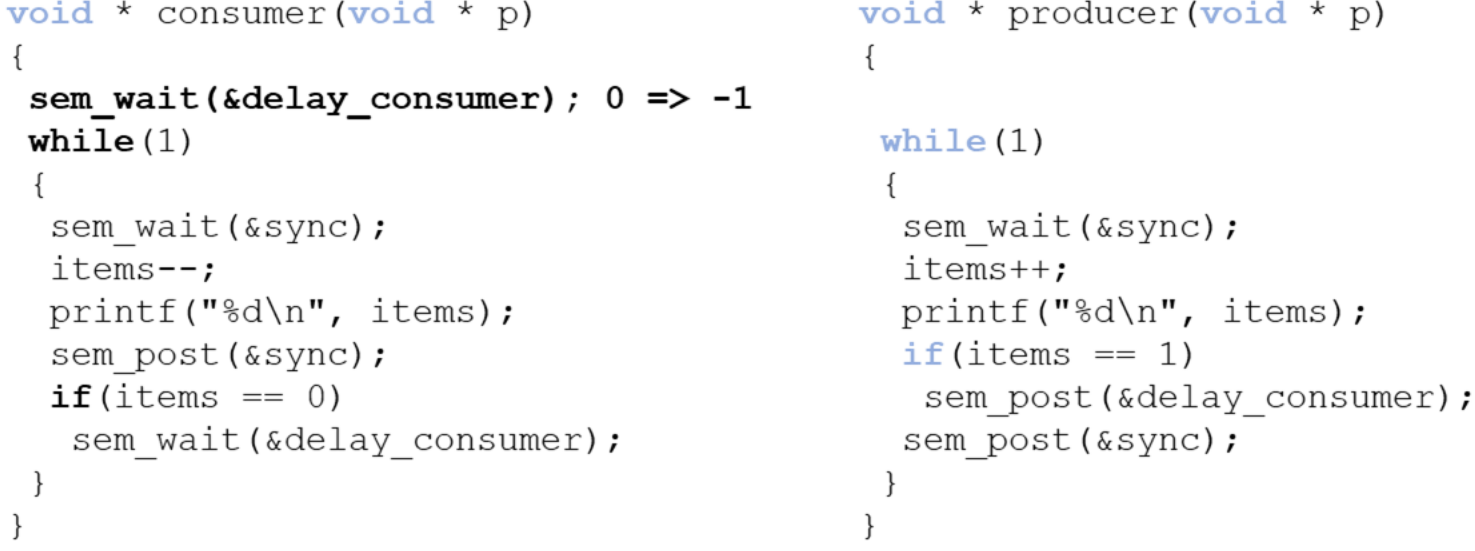8. Mutexs & Semaphores
21/10/22
Mutex Locks
- Mutexes are an approach for mutual exclusion provided by the operating system.
- Contains boolean lock variable to indicate
- Lock variable is set to true if the lock is available. false if unavailable
- Two Functions used. These must be atomic instructions:
acquire()- called before a critical selection, sets bool to falserelease()- called after the critical section, sets bool to true
- The process that acquires the lock must release the lock
- Key disadvantage of mutex locks is that calls to
acquire()result in busy waiting. Detrimental for performance on single CPU systems. - Key advantages of mutex locks include:
- Context switches can be avoided
- Efficient on multi-core/multi-processor systems when locks are held for a short time only
- Single core is easy to waste time, multi core higher chance it gets released quickly as it could be on a separate core
Mutexs binary lock
 Mutex Example
Mutex Example
 Mutex Example
Mutex Example
Semaphores
Doing the opposite, put the process on the execution, and puts it to sleep.
- Semaphores are an approach to mutual exclusion provided by the operating system
- Contain an integer variable
- Well distinguish between binary (If negative means processes are available.) and counting semaphores. (User uses it so it can go above 1.)
- Can be used to force mutual exclusion, and represent resources
- Two atomic functions:
wait()- called when a resource is acquired, the counter is decrementedsignal()/post()- is called when a resource is released
- Strictly positive values indicate that the semaphore is available, negative values indicate the number of processes/threads waiting
 Semaphores example
Semaphores example
- Calling
wait()will block the process/thread when the internal counter is negative- Process/thread joins the blocked queue
- Process/thread state is changed from running to blocked
- Control is transferred to the process scheduler
- Calling
post()removes a process/thread from the blocked queue if the counter is equal to or less than 0- Process/thread state is changed from blocked to ready
- Joins the read queue
- Different queuing strategies can be employed to remove processes/threads. Queue as FIFO
block()andwakeup()are system calls provided by the OSpost()andwait()must be atomic. Can be achieved through mutexes. Busy waiting is moved from the critical section towait()andpost() Mutexes vs Semaphores
Mutexes vs Semaphores
Mutexs can be implemented as semaphore.
- Semaphores within the same process can be declared as global variables of the type
sem_tsem_init()- initialises the value of the semaphoresem_wait()- decrements the value of the semaphoresem_post()- increments the values of the semaphore
Efficiency
- Synchronising code does result in a performance penalty
- Synchronise only when necessary
- Synchronise a few instructions as possible (unnecessary instructions will delay others when entering critical state)
Caveats
- Starvation: Poorly designed queuing approaches (LIFO) may result in fairness violations
- Deadlocks: Every thread in a set is waiting for an even that can only be caused by another thread in the same set
- Priority inversion: high priority process waits for a resource held by a low priority process
- Priority inversion can happen in chains. Prevented by priority inheritance/boosting
The Producer/Consumer Problem
- Producers and consumers share N buffers that are capable of holding one item each.
- Buffer can be bounded or unbounded size
- Can be one or multiple consumers and/or producers
- The producer(s) adds items and goes to sleep if the buffer is full
- The consumer(S) removes items and goes to sleep if the buffer is empty
First Version
- One producer, one consumer, and an unbounded buffer.
- A counter (index) represents the number of items in the buffer
- The solution uses two binary semaphores:
sync: synchronises access to the buffer (counter) - initialised to 1delay_consumer: puts the consumer to sleep when the buffer is empty - initialised to 0
 Single producer/consumer with unbounded buffer
Single producer/consumer with unbounded buffer
- Any manipulations of count will have to be synchronised.
- Race conditions still exist
- When the consumer has exhausted the buffer, should have gone to sleep, but the producer increments
itemsbefore the consumer checks it
- When the consumer has exhausted the buffer, should have gone to sleep, but the producer increments
Second Version
 Single producer/consumer and an unbounded bugger: Race condition (items = -1
Single producer/consumer and an unbounded bugger: Race condition (items = -1